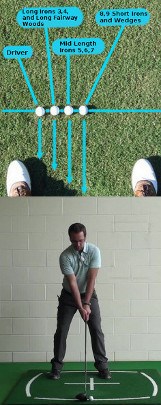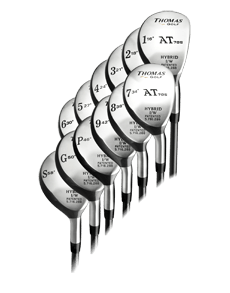
Just as important as knowing how to hit this shot is knowing when to hit this shot. Having the ability to hit a tee shot from back in your stance will do you no good whatsoever if you consistently attempt this shot when it isn’t called for. Shot selection is a valuable skill in golf, so don’t take this part of the equation for granted. 
To wrap up our discussion on the topic of tee shots played from back in your stance, let’s highlight a few points related to shot selection.
- Only when necessary. This should not be your ‘default’ tee shot option. As mentioned earlier, you are going to give up some distance when you hit this kind of shot. SO, you don’t want to turn to this type of tee shot unless it is a necessary. For example, if you are playing a wide par five with plenty of fairway to work with, it would be silly to use this option. Instead, hit your standard driver shot and maximize your distance.
- As this is a control-based shot, it is going to be the right choice when maintaining control over your ball is the top priority. A common example of such a situation would be a short, narrow par four with hazards in play off the tee.
- Only when it looks right. Sometimes, a shot just doesn’t ‘fit your eye’. You need to learn to listen to this gut instinct, and make adjustments to the shots you hit if necessary. To continue the example from the previous point, you might step up to a short, narrow par four and just not feel comfortable with this shot. And that’s okay. The last thing you want to do is force yourself to hit a shot that doesn’t feel comfortable. If you don’t think it will work, move on to another idea and use it instead.
- Only when you’ve practiced. This one should be a no-brainer, but it isn’t, unfortunately. Plenty of golfers attempt to hit shots that they have never previously tried, which is simply a bad idea. Add this shot to your game on the range first and you will have much more success out on the course.
We hope you now have the motivation you need to work on hitting some tee shots from back in your stance. Should you hit all of your tee shots this way? Of course not. It is a good trick to have available from time to time, however, as you might be able to hit a narrow fairway that you usually miss. Keeping your ball in play might not be the exciting part of the game, but it goes a long way toward a better score.
The “back in stance” driving technique refers to positioning the golf ball slightly farther back in your stance when hitting a driver off the tee. This technique is commonly used to promote a more sweeping strike, increase launch angle, and reduce unwanted spin. Here's a breakdown of the back in stance driving technique and some associated strategies:
- Ball Position: For the back in stance technique, position the golf ball slightly back in your stance, closer to your trail foot (right foot for right-handed golfers). The exact position will vary depending on your swing and preferences, but a general guideline is to have the ball in line with the inside of your trail foot's heel.
- Stance Width and Alignment: Maintain a shoulder-width stance or slightly wider for stability and balance. Align your feet, hips, and shoulders parallel to the target line or slightly open to accommodate your desired shot shape.
- Tee Height: Adjust the tee height so that the ball sits slightly higher off the ground, aligning it with the crown of the driver. This setup allows for an upward sweeping motion through impact.
- Swing Path and Angle of Attack: With the back in stance technique, the swing path tends to be more of an upward strike, promoting a higher launch angle and reduced spin. Focus on sweeping the clubhead through the ball, feeling like you're hitting up on it rather than down.
- Clubface Alignment: Ensure that the clubface is square or slightly open at address. With the upward swing path, a slightly open face can help counteract any potential slice tendencies.
- Strategy: The back in stance technique is commonly used when facing tight fairways, windy conditions, or when seeking more distance off the tee. By hitting up on the ball, you can achieve a higher launch, reduce spin, and potentially hit longer drives. This technique may sacrifice some accuracy, so it's important to consider the trade-off between distance and control.
Remember, the back in stance technique may not be suitable for every golfer or every situation. It's essential to experiment with different ball positions, tee heights, and swing adjustments during practice sessions to find what works best for your game.
Additionally, seeking guidance from a golf instructor or coach can provide personalized recommendations and help you refine your technique for optimal performance. They can also assess your swing and provide specific strategies based on your strengths and weaknesses.
Lastly, while technique plays a crucial role in driving, it's important to develop a strategic approach that considers the specific demands of each hole and course layout. Factor in hazards, doglegs, wind direction, and other course conditions when selecting your target and deciding on shot shape and club choice.
Overall, the back in stance driving technique can be a valuable tool in your golf game, offering potential distance gains and adaptability to certain situations. However, it's important to find the right balance between distance and accuracy and to adjust your strategy accordingly.
Update:
Back In Stance Golf Driving Techniques and Strategy:
Techniques:
- Ball Position:
- Place the golf ball slightly farther back in your stance than usual. This promotes a steeper angle of attack, which can help reduce backspin and launch the ball lower.
- Weight Distribution:
- Shift a bit more weight onto your back foot at setup. This helps promote a downward strike on the ball, creating a more penetrating ball flight.
- Hands Ahead of the Ball:
- Position your hands slightly ahead of the ball at address. This forward press encourages a descending blow through impact.
- Stable Lower Body:
- Keep your lower body stable during the swing. Minimize lateral movement to maintain a solid base and enhance control over the clubhead.
- Compact Backswing:
- Aim for a slightly shorter and more controlled backswing. This can help ensure a more consistent and on-plane downswing.
- Focus on Accuracy:
- Emphasize accuracy over distance. The back in stance technique is often employed in situations where control is crucial, such as hitting fairways or avoiding hazards.
Strategy:
- Tight Fairways:
- Use the back in stance technique when faced with narrow fairways where accuracy is paramount. The more controlled approach can help keep the ball on the short grass.
- Into the Wind:
- In windy conditions, especially when driving into the wind, the back in stance technique can produce a lower ball flight, reducing the impact of the wind on the shot.
- Avoiding Trouble:
- When there are hazards or trouble on one side of the fairway, using this technique can help you steer clear of potential problems and keep the ball in play.
- Firm Course Conditions:
- On firm and fast-running courses, a lower ball flight from the back in stance technique can lead to extra roll, maximizing overall distance.
- Precision Over Power:
- Choose this technique when precision is more important than maximizing distance. It's a valuable strategy in situations where positioning is critical.
Q&A on Back In Stance Driving Techniques and Strategy:
- Q: Can the back in stance technique be used with all clubs, or is it specific to the driver?
- A: While it's commonly associated with the driver, variations of the technique can be applied to other clubs when control is prioritized.
- Q: Does using this technique sacrifice distance?
- A: Yes, the back in stance technique may sacrifice some distance, but it aims to enhance accuracy and control.
- Q: Is the back in stance technique suitable for all skill levels?
- A: It can be adapted by golfers of various skill levels, but it's particularly useful for those who struggle with accuracy off the tee.
- Q: How does the ball position change in the back in stance technique?
- A: The ball is typically positioned slightly farther back in the stance, encouraging a more downward strike.
- Q: Can the technique help in avoiding slices or hooks?
- A: Yes, the back in stance technique may help minimize the side spin that contributes to slices or hooks.
- Q: Should I use this technique in every driving situation?
- A: No, reserve this technique for situations where accuracy is crucial. In wide-open fairways where distance is the primary goal, a more neutral setup may be preferred.
- Q: How can I practice the back in stance technique?
- A: Start with shorter clubs and gradually work up to the driver. Practice on the range, focusing on a stable lower body and controlled backswing.
- Q: Does this technique help with hitting low punch shots off the tee?
- A: Yes, the back in stance technique can contribute to hitting lower trajectory shots, useful in windy conditions or to avoid obstacles.
- Q: Can it be used effectively in wet or soft course conditions?
- A: It's generally more effective on firmer courses where the lower ball flight can result in extra roll. In wet conditions, the benefits may be less pronounced.
- Q: Are there any potential drawbacks to using the back in stance technique?
- A: While it enhances control, it may lead to a loss of distance. Golfers should weigh the trade-off based on the specific demands of the situation.
Remember, individual golfers may have variations in their swings and preferences. Experiment with the back in stance technique during practice rounds to determine its effectiveness for your game in different scenarios.





